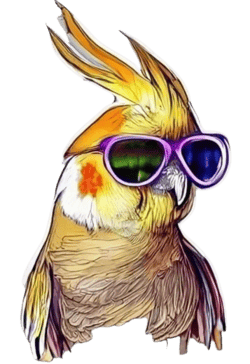How Big Do Cockatiels Get
I. Understanding Cockatiels: An Introduction
A. Brief Overview of Cockatiels
Cockatiels, scientifically known as Nymphicus hollandicus, are beloved for their friendly nature, captivating personalities, and charming looks. Native to Australia, these birds are of the most popular species of pet birds worldwide. Perhaps you’re considering adopting one or simply fascinated by their captivating character. Either way, this post will help you understand more about this intriguing species.
B. The Unique Characteristics of Cockatiels
Two distinct features make Cockatiels stand out in the world of pet birds: their cheek patches of shimmering orange, and an expressive crest situated on their head which lifts and lowers in response to their emotions. Plus, their wide range of vocalizations and whistles offer a captivating aural experience too.
C. The Origin and Natural Habitats of Cockatiels
Cockatiels hail from the Land Down Under, Australia, where they thrive in arid or semi-arid conditions. They particularly enjoy habitats near water sources and adapt well to various environments, including woodlands, scrublands, and farming regions.
II. Physical Traits: Size, Weight, and More
A. Typical Size Range of Cockatiels: How Big Do Cockatiels Get
So you might be wondering, just how big do Cockatiels get? Typically, a mature Cockatiel ranges from 12 to 13 inches (30 to 33 cm) from head to the end of their long tail feathers- slightly larger than a common dove. Their height, however, stands slightly taller, with most reaching about 7 or 8 inches.
B. Average Weight and Its Variations
On average, Cockatiels weigh between 75 to 125 grams. Factors such as diet, exercise, and overall health can significantly influence a Cockatiel’s weight.
C. Feature Size: Crest, Tail, and Wings
Besides overall size, the length of their crest, tail, and wings also reveal interesting aspects of Cockatiel morphology. A healthy Cockatiel’s crest averages around 2 inches, while their tail and wings can each reach up to 7 inches.
III. Factors Affecting Cockatiels’ Size and Growth
A. Genetic Factors and Breed Variations
Like many creatures, Cockatiels’ size and growth are significantly influenced by their genetics. Different Cockatiel subspecies might display minor size variations. For instance, the Lutino Cockatiels can be fractionally larger than their cousins.
B. Environmental Influences on Size
Cockatiels’ living conditions can also impact their growth. A stress-free environment, spacious enough for some flight, promotes optimum growth.
C. The Impact of Diet on Cockatiel Growth
Diet profoundly affects Cockatiel growth, with a balanced diet of seeds, pellets, and a variety of fruits and vegetables asserting a decisive role in their physical development.
IV. Cockatiel Maturity: When Are They Full Grown?
A. Growth Timeline of Cockatiels
Cockatiels reach their full size between 6 to 9 months of age, depending on their overall health and nutrition.
B. Signs of a Mature Cockatiel
Maturity in Cockatiels is generally marked by the development of their full-color pigmentation, which happens around the same time they reach their final size. Also, the feathers of adult Cockatiels are more vibrant and shiny compared to their juvenile counterparts.
C. Differences Between Juvenile and Adult Size
While juvenile Cockatiels are noticeably smaller, they quickly catch up. By the time they’re 6 months old, most Cockatiels have reached their adult size, making it quite tough to discern between a juvenile and an adult based on size alone.
V. Comparisons: Cockatiel Size with Other Pet Birds
A. Size Comparison with Similar Pet Birds
Compared to other popular pet birds, Cockatiels sit in the mid-range. They are larger than budgies but smaller than the popular African Grey parrots.
B. Understanding the Cockatiel Space Needs
Owing to their size, Cockatiels demand a fair bit of space. They need large, roomy cages for optimal health and happiness.
C. How Cockatiel Sizes Impact Pet Keeping
No doubt, owning a big bird comes with added responsibilities. Bear in mind, while these birds might not be the largest parrots out there, their need for spacious cages, regular exercise, and a balanced diet should not be underestimated.
VI. Conclusion: Summarizing Cockatiel Size and Growth
Ultimately, the size of your feathered friend has countless implications. The ability to understand the growth timeline and factors influencing it comes in handy when caring for your pet Cockatiel. Remember, a balanced diet, healthy environment, and your unreserved love are pivotal to your Cockatiel’s health, growth and overall happiness.
If you’re curious about trimming your cockatiel’s nails and want expert guidance, check out our guide on “How to Trim Cockatiel Nails” for more information.
VII. Frequently Asked Questions (FAQs)
A. How Can I Tell If My Cockatiel is Fully Grown?
Your Cockatiel’s full coloration and the cessation in significant size increase typically signal their full growth. However, consult with your vet for a precise assessment.
B. Does the Size of the Parents Affect the Size of the Cockatiel Chick?
Yes, the size of the parents can play a role in determining the size of the Cockatiel chick. Genetics can influence the overall size and growth rate.
C. Do Male and Female Cockatiels Vary in Size?
Generally, there isn’t a significant size difference between male and female Cockatiels. However, some observations suggest that female Cockatiels might be slightly smaller.
Please consult with a qualified avian vet for precise and personalized information about your pet’s health and growth. Information provided here is based on general observations and might vary in individual cases.

About Me
I’m Kamran, a co-founder and content creator at cockatielhq.com. With 8+ years in the world of avian enthusiasts, I’ve gained extensive knowledge in caring for birds. From egg-laying and mating to cohabitation with other birds, dietary needs, nurturing, and breeding, I’m here at cockatielhq.com to share valuable insights for your avian companions.








2 Comments